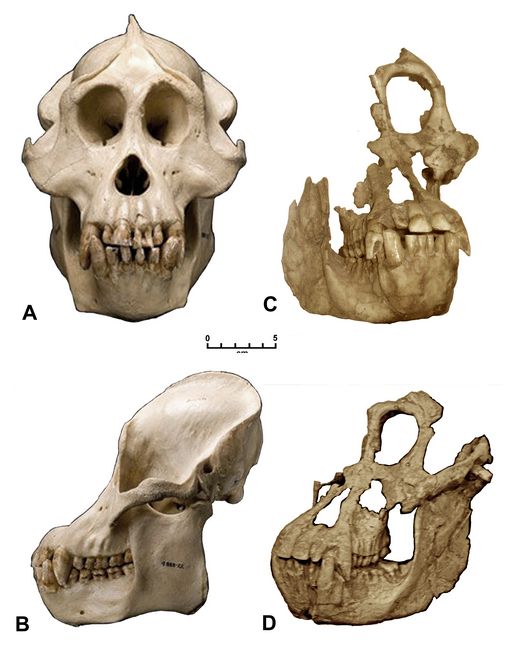Athena Review Image Archive ™
Orangutan and Sivapithecus skulls

Orangutan (A,B) and Sivapithecus (C,D) skulls in frontal and profile views (after)
Sivapithecus was a Miocene ape who lived in the Siwalik area of northern Pakistan between 13-8 mya. Originally discovered in the 19th century, it has been intrepreted as a fruit-eating quadrupedal ape about 5 feet tall, who probably spent most of the time in trees. There are three species. including the the earliest, S. indicus; the largest, S. parvada; and S. sivalensis.
Sivapithecus is considered to be the ancestor of the Southeast Asian ape Pongo pygmaeus, the orangutan, whose two varieties now live in Borneo and Sumatra. Sivapithecus and Pongo share several derived cranial features including a high degree of prognathism, oval orbits, a narrow nasal aperture, and broad zygomatic arches. In these features, and in their high, rounded braincase, the skulls of Orangutans differ from that of the African great apes (Fleagle 1999).
The image shows similarities of the skull forms of orangutans and Sivapithecus in both frontal and profile views. Both, identified as male skulls, have prognathic or projecting faces with large canines and incisors.
Like the orangutan, Sivapithecus showed considereble sexual dimorphism. The smaller, more gracile female skull of Sivapithecus was formerly thought to be a separate species called Ramapithecus, which from the 1930s through 70s was interpreted as a possible hominid ancestor, until conclusively identified in the early 1980s as a female variant of Sivapithecus (Pilbeam 1982).
References:
Fleagle 1999.
Pilbeam, D. 1982
Copyright © 1996-2020 Rust Family Foundation (All Rights Reserved).